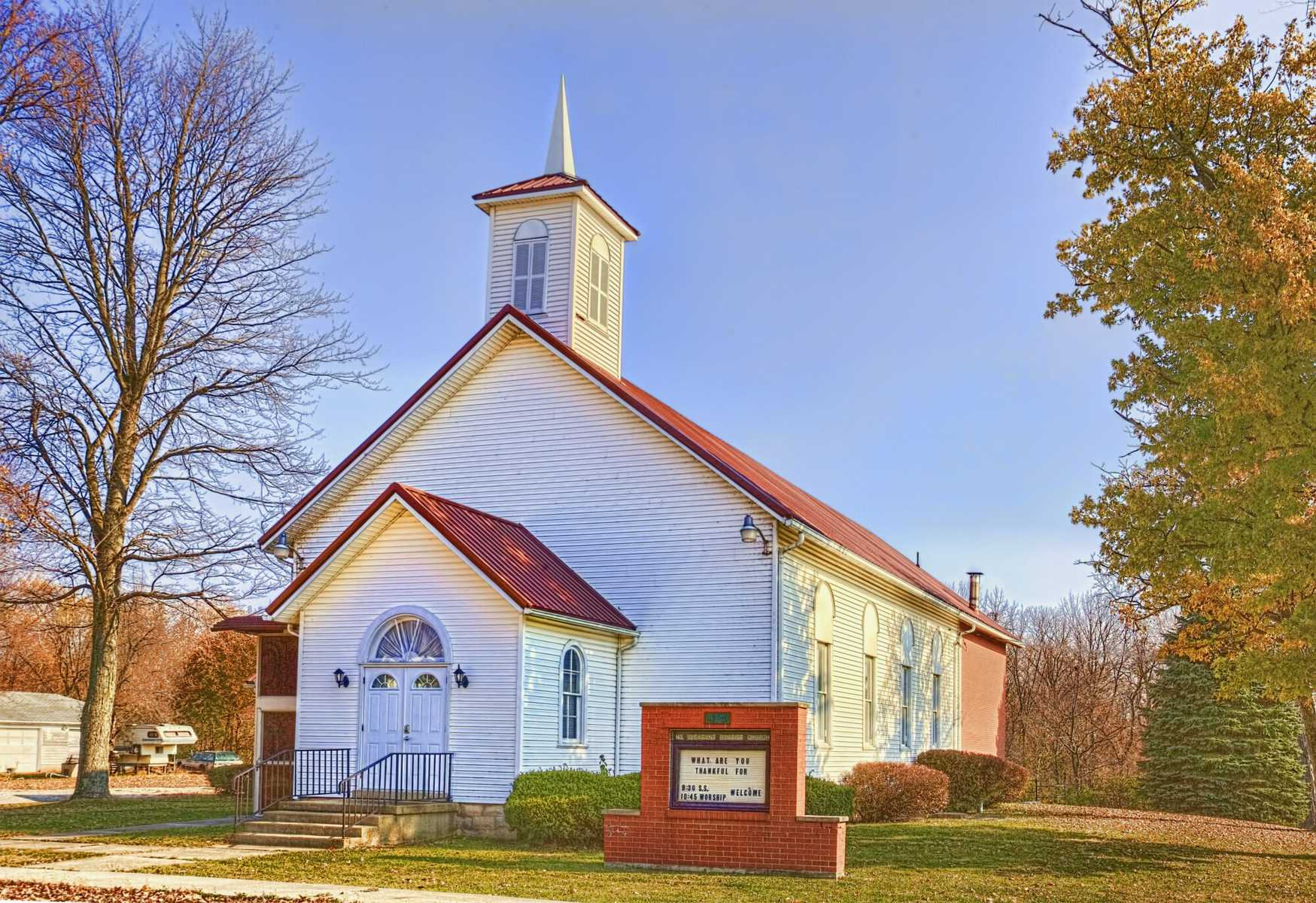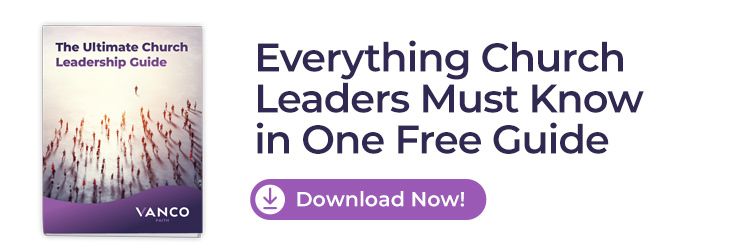 If you’re unaware of how to make your church grow, consider church leadership structure models. It’s not easy to alter a leadership structure, but it may help accommodate the growth of the church.
If you’re unaware of how to make your church grow, consider church leadership structure models. It’s not easy to alter a leadership structure, but it may help accommodate the growth of the church.
Growing a church takes more than prayer and preaching to the choir. One of the main barriers to growth in a church is its structure. What leads to success in growing a church is coming up with a well-maintained church organizational structure.
A leader must also pursue with passion and build a vibrant community. Part of the structure you can’t forget about creating is a church administration that works seamlessly, keeping members informed and engaged with tools like a church financial report. This often comes from a church finance committee, which helps manage a church's finances and budget.
Discover church leadership models that churches can use to build healthy leadership and a churchorganizational structure that supports growth.
Table of Contents
- Different Leadership Roles in The Church
- Church Leadership Structure Models to Grow Your Congregation
- How to Implement a New Church Leadership Structure
- Why Is Church Organizational Structure Important?
- FAQs
Different Leadership Roles in The Church
Leadership roles and church administration structures are not something you should take lightly. There are many different leadership roles in churches, but each plays an integral part in what makes a church successful.
Pastor
A pastor is the leader of a church. The title “pastor” also refers to specific roles within a church. These roles typically include:
- Preaching and teaching during worship services
- Discipling believers one-on-one or in small groups
- Providing counseling
Other duties of the pastor include administrative tasks such as planning events and activities for church members to participate in outside of worship service times. In most cases, pastors get help from other pastors, elders, and deacons to help carry out the responsibilities of shepherding God’s people.
Bishop
Bishops are the highest level of leadership in many churches and are important to consider in your church leadership structure models. They have authority over a group of churches and are often called overseers or superintendents. A bishop must also maintain proper doctrinal interpretation within each parish under their jurisdiction.
As such, bishops are not responsible for day-to-day decision-making. Instead, they support the work of local pastors and congregations through their travels from church to church.
In the church, bishops help keep things running smoothly and make decisions about things like preaching, giving out the sacraments, ensuring that people have faith and morals, and teaching them about religion.
While their roles may sound similar to a pastor’s, bishops are leaders of the Christian clergy, while pastors are the ordained leaders of the Christian congregation.
Elder
An elder is a church leader who serves within the church and its community. But what does that mean? According to 1 Peter 5:1-4, elders are godly men of character who shepherd the people in their care.
They look out for the spiritual health of God’s people by leading by example. For instance, elders should be “above reproach” because they are well-respected in their communities (1 Timothy 3:2).
Additionally, they should be men of prayer and Scripture study to help them understand how to guide others.
The responsibilities of elders vary depending on the size and needs of each church. For example, some churches see their elders as primarily responsible for teaching and preaching from Scripture. However, the preaching may fall on pastors or deacons in other churches.
Yet, most churches have elders who serve on committees that deal with budgeting or outreach.
Minister
A minister has many different meanings in Christianity, but essentially it describes anyone who acts in service to others through prayer or by teaching about their faith. Ministers can be either male or female, even children.
Ordained ministers are clergy who serve as leaders within their respective churches. Ministers can also be bishops and elders, should their church choose to ordain them.
Associate Pastor
An associate pastor is a minister who works under a senior pastor. The term "associate pastor" is typically used to describe an ordained minister who serves in a church's executive or assistant leadership position. An associate pastor may take on many different roles within the church, including youth ministry, administrative, and outreach.
Deacon
Deacons are responsible for assisting the pastor and elders in leading the congregation. This includes tasks such as:
- Caring for community members who are sick
- Welcoming visitors
- Serving communion
- Working with youth
They should be good role models for others in the church, setting a high example of what it means to walk in faith.
Chaplain
A chaplain works in places like hospitals, prisons, nursing homes, and military facilities. These are places where people are often facing difficult times. A chaplain's job is to listen to these people and help them understand their situation from a religious point of view.
To be a chaplain, you must be a member of the clergy within your faith tradition. In addition, you should have a good understanding of human nature to help people through difficulties. Chaplains should also be a good source of information for anyone who questions religious beliefs.
Church Leadership Structure Models to Grow Your Congregation

According to one survey, about 27 percent of Americans attend church every week. To put that into perspective, that's close to 90 million people! In light of these statistics, there's no reason why your church shouldn't be growing with proper church administration strategies.
Your church might not be growing at a desirable rate. Church organizational structure contributes to the growth and expansion. If you're wondering how to improve your church leadership structure, you have come to the right place.
Read on to learn about the different leadership styles in church ministry you can implement to grow your church.
The Pastor and Bishop Model (Episcopal)
Episcopal churches have managed to maintain over 400,000 members in the US. And there’s a good reason for this: episcopal churches have a clear church heirarchy.
An Episcopal church follows the pastor and bishop model. The pastor, or priest, is the leader of the local congregation. The bishop usually leads a group of pastors.
In this model, the pastor is responsible for conducting worship and overseeing the spiritual side of parish life. The bishop takes responsibility for specific duties that may be beyond what the local pastor can do on his own time and resources, such as:
- Ordaining new priests and deacons
- Serving as a liaison between local churches and other Christian denominations outside their geographical jurisdiction
- Periodically meeting with clergy from within his/her diocese to discuss pastoral leadership frameworks
- Conducting confirmations at individual parishes
- Overseeing the distribution of communion to hospitalized members
With this model, the pastor can focus on church growth strategies and leave the bishop to his religious duties.
How the Episcopal Model Can Help Grow Your Congregation
One crucial difference between episcopal leadership and other models is that the bishop is in charge of the church. Because the bishop takes care of the most important tasks in the church, the pastors have more time to meet with other people and spread the word, inspiring new visitors to join.
Pastors in this faith are not ordained in the same way as priests in other denominations. Rather than being anointed by men to serve God forever, they have day jobs outside the church. This arrangement keeps their fingers on the pulse of modern society so they can bring new insights into what people are looking for when picking a church.
With this information, the congregation can form strategies to intrigue new members, such as:
- Openly preaching their message in high-traffic areas
- Creating new services that cater to different age groups and interests
- Integrating technology into their services (live streaming)
Once you have a models of church leadership in practice who provide information, you’ll see consistent success.
The Pastor, Elder and Deacons Model (Pentecostal)
Pentecostals believe that these church leadership structure models are prescribed in Scripture, so they should follow them as closely as possible. Therefore, most Pentecostal churches have three leadership positions.
At the top, there is the pastor. They are the head of the church and are responsible for teaching the Word.
Next, there are the elders. The congregation elects these men to oversee the spiritual needs of a particular local body member.
Following this position are the deacons. The members of a congregation elect them to help with the day-to-day operations of the church like those mentioned above.
How the Pentecostal Model Can Help Grow Your Congregation
The difference between the Pentecostal model and other Protestant models is that the Pentecostal model seeks to follow the Scripture. If your leadership structure has its roots in The Bible, it will draw in more Christians who respect the Word.
Moreover, the Pentecostal model clearly defines the roles of each member, elder, and deacon of the church.
Pastors can commit to leadership because they have a clear vision concerning the church's direction. Elders have the same mentality and help members find their place within the Bibilical church structure.
The final piece of this model is the deacon's commitment to service. They are empowered because they know that their service is essential for church operations and directly helps God's kingdom grow here on earth.
In this structure, members are encouraged to find what they are passionate about or gifted in and use it as part of their worship experience. Members also feel an obligation to serve because they know what they're called to do.
If you implement this model, new church visitors will be encouraged to stay because they will have the opportunity to join the church's life.
The Congregational Model
In congregational church leadership structure models, each local congregation is independent and self-governing. The church determines its policy, doctrine, and leadership issues. Structures may vary, but most have some form of elder board or board of deacons to handle administrative duties while the pastor is responsible for preaching and teaching.
In a congregational model, the pastor is hired by the church board or a member vote. The pastor does not have any authority over other churches and represents only himself and his congregation.
This model allows for significant autonomy but leaves it up to the church to determine its leaders and structure. Even though there are many different forms of this model, they all share one thing in common: each church is self-governing, with no outside authority having jurisdiction over them except that granted by its membership.
How the Congregation Model Can Help Grow Your Congregation
The congregation can vote on lessons, teachers, and other vital issues. They are more likely to attend and invite others because the church is run democratically.
Church members should not be feel controlled to follow the pastor, and they should be able to vote for what they believe is best for their congregation. The congregation model aims to help people grow spiritually by delivering precisely what they need.
If new members know that their problems and questions will be addressed promptly, they are more likely to join.
The Pastor, Council President and Board of Elders Models (Lutheran)
A Lutheran church is led by three different positions: pastor, council president, and chairman of the board of elders.
The pastor is the spiritual leader of a congregation. They oversee worship services and work closely with members to provide community counseling and other support. These pastors also teach in schools connected to their congregations.
The council president leads a higher-level church management team, the board of directors. This team sets the congregation's budget, makes personnel decisions, and is responsible for building maintenance.
The chairman of the Board of Elders leads another group that provides spiritual guidance for members and leaders within the congregation.
How the Lutheran Model Can Help Grow Your Congregation
In the Lutheran model, the congregation elects the church council and its president. The church council oversees the church's day-to-day operations; the pastor serves as an advisor to the board. This allows for a great deal of autonomy on behalf of both parties.
The pastor does not have to worry about administrative tasks like bookkeeping or managing staff; they can focus entirely on ministry. And because each member of the church council is elected by his or her peers, accountability and transparency are guaranteed. This helps create an atmosphere where everyone knows their concerns will be heard and addressed.
Like the Lutheran model, new church members will be happy to know that they can express their opinions. However, this model has the added advantage of elders who can focus solely on the congregation's spiritual growth in making the decisions.
The Pastor, Deacons and Treasurer Model (Baptist)
Baptist churches have a fairly simple model of church leadership. At the top is the pastor, who has ultimate authority and makes final decisions on all matters.
Deacons are appointed by the congregation to provide spiritual guidance and to serve in an advisory capacity. They also handle the business affairs of the church, such as taking care of property maintenance, deciding on budgets, etc.
The treasurer keeps track of money and books, making sure bills get paid on time and collecting tithes and donations from members.
How the Baptist Model Can Help Grow Your Congregation
The success of this model lies largely in its ability to bring new people into regular contact with members of that local congregation. For example, you must reach out to the treasurer to submit your donations and go to the deacons to better understand The Bible. This arrangement provides a sense of community because members know who to turn to with a specific question.
This model eliminates confusion amongst your congregation and makes the church appear more orderly. Members will be attracted to the church because it has a clear system for spiritual growth.
How to Implement a New Church Leadership Structure

After you’ve reviewed the different structures and found one that resonates with you, it’s time to put it into practice. If none of the previous church models resonate with you, you can take the elements of each and create your own church administration structure. In either case, there are steps involved when trying to modify the entire culture of a church.
Step One: Identify Your Problem
Identifying your problem is a process that may take months. You will need to gather information on the current leadership structure in general and as it relates to your church. Here are some questions you can ask yourself:
- What is the problem? How would you describe it?
- What are its symptoms? Is it affecting the church’s growth, budget, reputation or other areas?
- Who does it affect most: the congregation or leadership? Or both?
- What don’t you like about your current system of governance and leadership development?
Answering these questions can lead to effective church governance and show you exactly what needs to improve in your church.
Step Two: Have a Meeting
The second step is to have a meeting with the elders of your church. The goal of this meeting is to discuss and get feedback on the potential solutions you've identified.
Choose a time when everyone can relax and think aloud about the problem for an extended period. If people are free to speak their minds, they're also more likely to be receptive to new ideas. Ensure this occurs in a healthy environment by establishing ground rules for meetings.
Additionally, be sure to give all parties an equal amount of time to speak up during this step. While it's important for leaders to address issues within their congregations in a timely manner, don't rush through this portion just for the sake of keeping things moving along quickly.
You should also make sure that everyone involved in the process understands what kind of solutions you're looking for, and why these changes are necessary. What's important at this stage is that everyone agrees on what needs fixing, because it's difficult to fix something if everyone has a different idea of what "fixing" means.
Step Three: Let the Church Members Vote
The only thing left to do is have the congregation vote on the final solution. Gather everyone and ask for a show of hands. Count them and determine the outcome.
If it’s a tie, have another vote. If it still ties, use a random selection to pick the winner. Let everyone know how the vote went and inform them of the changes you plan to implement.
If your proposal doesn't pass, don't get discouraged; this process takes time and patience. Simply come up with another plan or restructure your initial plan to make it more agreeable.
Remember, this one voting session will not transform your leadership structure into that of a congregational church unless that is your goal. At this stage, the church members must have a say in such a big shift.
Why Is Church Organizational Structure Important?

If you truly want to be part of a church and feel good about coming back each Sunday, then you need to focus church structure and community building and lead effectively.
The Bible says that you should submit to church leaders, and you can see in Ephesians 4:12-16 that an organized system is the best way to do that. And while you may believe that your congregation is growing in faith without a church leadership structure, there are great benefits for everyone by having a structure in place.
Organized Leadership Increases the Effectiveness of Discipleship and Ministry
When someone is saved by God, they are given new life in Christ. They become a part of the church family. As such, the church should work to help one another grow in faith and live out their lives for Jesus Christ.
Church leaders need organization to effectively disciple others and give them opportunities to serve. With bad leadership and no structure, church members may find it difficult to plug into ministry or feel like they're not making an impact on others' lives. This can lead to a drop in the effectiveness of the church's discipleship and ministry.
Leadership may not come naturally to every church official. Training may be required. However, with the right approach and a sense of transparency, the community will come together to support leaders in their goals.
Helps Keep Large Churches Focused
As a church grows, it must keep its mission in mind.
Typically, small churches have an individual pastor in charge of all aspects of ministry programming and vision direction. On the other hand, large churches struggle with clear leadership structures because the responsibility for leading is spread across more than one person. This often leads to disagreements about how resources should be allocated and what direction the church should go.
Optimizing church leadership is essential as the church grows. It ensures structure models that keep the church focused on its mission.
FAQs
What is the Importance of a Strong Church Structure?
A strong church structure helps your church grow. It offers a clear framework for church leaders. Structure also ensures church leaders deliver a consistent message promoting unity among members.
How Does Church Structure Influence Leadership Effectiveness?
Church structure provides a leadership framework. Leaders understand the message the church is sending to members and ensure it is communicated in their sermons and activities. It also guides decision-making within the church.
What are the Different Types of Church Leadership Models?
Church leadership models are typically guided by the church's faith. For example, there are Lutheran, Episcopal, and Pentecostal church leadership models. However, there is no reason why you can't be inspired by church models outside your faith.
How Can a Church Structure Promote Growth and Unity?
Most churches are seeing a decline in membership. In fact, both the Presbyterian Church and the Southern Baptists Convention have reported small declines in the low single digit percentage points for years now. In the case of these denominations and others, the decline was made worse by COVID, which seems to have weakened the bonds of many church communities. With most churches seeing a drop in membership, churches must promote unity. A strong structure promotes unity among members ensuring leaders send a consistent message. It also promotes unity among church leaders ensuring every voice is heard in decision-making.
How Can Church Structure and Leadership Adapt to Modern Needs?
Churches can adapt to modern needs by becoming involved with their members and learning what they are seeking to achieve through worship. Youth outreach programs are also helpful. The Episcopal model, in which pastors have day jobs, also ensures church leaders understand how their organizations can evolve in modern times.
Get Everything Church Leaders Must Know in One Free Guide
Get the tested church leadership strategies and techniques used by top ministries to build healthy and growing congregations. Download our free eBook to learn…















